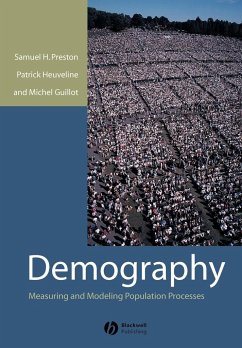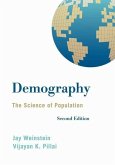This book presents and develops the basic methods and models that are used by demographers to study the behaviour of human populations. The procedures are clearly and concisely developed from first principles and extensive applications are presented.
Hinweis: Dieser Artikel kann nur an eine deutsche Lieferadresse ausgeliefert werden.
Hinweis: Dieser Artikel kann nur an eine deutsche Lieferadresse ausgeliefert werden.
"This will be a bible for demographers in coming years anddecades." Professor James Vaupel, Founding Director, Max PlanckInstitute for Demographic Research, Rostock, Germany
"It is really a graduate-level textbook of formal demography. Assuch, it is sorely needed. I will certainly use it as my basictextbook when it comes out. The authors have done an excellent jobof keeping this interesting and informative." Professor KennethHill, Director of the Johns Hopkins Population Center
"It is not a text on population geography. That was not thecreative intention of the authors: they provide a carefully craftedtoolkit for advanced exercises on demographic analysis. It succeedsas an undergraduate level text and is reasonable priced"Geographical Association
"For the mathematically competent, it is terrific. The coverageof the book is indicated by its 12 chapters: basic concept andmeasures, age-specific rates and probabilities, the life table andsingle decrement processes, multiple decrement processes, fertilityand reproduction, population projections, the stable populationmodel, demographic relationships in non-stable populations,modelling age patterns of vital events, methods of evaluating dataquality, indirect estimation methods, and increment-decrement lifetables ( this chapter contributed by Alberto Palloni). As a text,the book could be used as a first course for those withparticularly good mathematical skills but it is probably betteremployed as a successor to a simpler methods course in which thefundamental ideas of demography have been made clear. The earliercourse would filter out those students who would most benefit froma course based on this book.
For the practitioner, this is an excellent reference book. Ittakes the fear out of a lot of mathematical material in demograohythrough clear and explicit explanantion...this is a five star book.Fantastic, terrific, exciting. Its authors deserve very greatpraise for the service that they provided to the discipline. Itsemergence has already led us here at the ANU to consider arestructuring of our teaching to incorporate a course based on thisbook." Journal of Population Research
"This is a five-star book. Fantastic, terrific, exiting. Itsauthors deserve very great praise for the service that they haveprovided the discipline." Journal of Population Research
"It is really a graduate-level textbook of formal demography. Assuch, it is sorely needed. I will certainly use it as my basictextbook when it comes out. The authors have done an excellent jobof keeping this interesting and informative." Professor KennethHill, Director of the Johns Hopkins Population Center
"It is not a text on population geography. That was not thecreative intention of the authors: they provide a carefully craftedtoolkit for advanced exercises on demographic analysis. It succeedsas an undergraduate level text and is reasonable priced"Geographical Association
"For the mathematically competent, it is terrific. The coverageof the book is indicated by its 12 chapters: basic concept andmeasures, age-specific rates and probabilities, the life table andsingle decrement processes, multiple decrement processes, fertilityand reproduction, population projections, the stable populationmodel, demographic relationships in non-stable populations,modelling age patterns of vital events, methods of evaluating dataquality, indirect estimation methods, and increment-decrement lifetables ( this chapter contributed by Alberto Palloni). As a text,the book could be used as a first course for those withparticularly good mathematical skills but it is probably betteremployed as a successor to a simpler methods course in which thefundamental ideas of demography have been made clear. The earliercourse would filter out those students who would most benefit froma course based on this book.
For the practitioner, this is an excellent reference book. Ittakes the fear out of a lot of mathematical material in demograohythrough clear and explicit explanantion...this is a five star book.Fantastic, terrific, exciting. Its authors deserve very greatpraise for the service that they provided to the discipline. Itsemergence has already led us here at the ANU to consider arestructuring of our teaching to incorporate a course based on thisbook." Journal of Population Research
"This is a five-star book. Fantastic, terrific, exiting. Itsauthors deserve very great praise for the service that they haveprovided the discipline." Journal of Population Research








